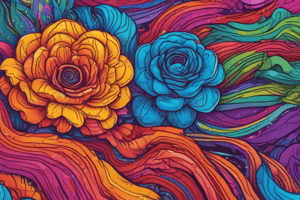Podcast
Questions and Answers
What is the primary purpose of dyeing in the textile industry?
What is the primary purpose of dyeing in the textile industry?
- To add texture to textile materials
- To protect textile materials from fading
- To apply color with desired color fastness (correct)
- To increase the durability of textile fabrics
How does dyeing differ from printing in textiles?
How does dyeing differ from printing in textiles?
- Dyeing uses artificial dyes while printing uses natural dyes
- Dyeing enhances the texture while printing adds color
- Dyeing applies color to the entire textile while printing is done with desired patterns (correct)
- Dyeing is done only on a localized area while printing covers the entire textile
What are organic colorants primarily made of?
What are organic colorants primarily made of?
- Water-soluble dyes and natural substances
- Carbon atoms and organic substances (correct)
- Inorganic pigments and carbon-based molecules
- Chemical dyes and carbon-containing substances
Why have humans produced artificial dyes since the mid-19th century?
Why have humans produced artificial dyes since the mid-19th century?
What is the major advantage of using synthetic dyes over natural dyes?
What is the major advantage of using synthetic dyes over natural dyes?
How is the process of ikat dyeing different from regular tie and dye techniques?
How is the process of ikat dyeing different from regular tie and dye techniques?
What leads to the blurred appearance of Ikat fabrics?
What leads to the blurred appearance of Ikat fabrics?
Why do Sanganeri prints stand out due to their intricate detailing?
Why do Sanganeri prints stand out due to their intricate detailing?
What makes Sanganeri block prints unique in terms of the background color used?
What makes Sanganeri block prints unique in terms of the background color used?
Which dyeing technique is described as the most ancient way of coloring fabric?
Which dyeing technique is described as the most ancient way of coloring fabric?
What is the first step in creating a fabric?
What is the first step in creating a fabric?
How are fabrics created from yarns?
How are fabrics created from yarns?
What substance is formed by spinning fibers and twisting them together?
What substance is formed by spinning fibers and twisting them together?
What is the final step in the creation of fabric after weaving?
What is the final step in the creation of fabric after weaving?
What is the difference between natural fibers and artificial fibers?
What is the difference between natural fibers and artificial fibers?
What is the process of removing fiber from seeds, such as cotton from cotton bolls, called?
What is the process of removing fiber from seeds, such as cotton from cotton bolls, called?
Which process involves arranging two sets of yarn together to make fabric?
Which process involves arranging two sets of yarn together to make fabric?
What is the purpose of sizing in the textile manufacturing process?
What is the purpose of sizing in the textile manufacturing process?
Which key term refers to the process of transferring yarn between packages during textile production?
Which key term refers to the process of transferring yarn between packages during textile production?
What outcome is achieved when the weft yarn crosses the warp yarns in weaving?
What outcome is achieved when the weft yarn crosses the warp yarns in weaving?
Study Notes
Dyeing in the Textile Industry
- The primary purpose of dyeing in the textile industry is to impart color to fabrics.
Dyeing vs. Printing
- Dyeing involves coloring the entire fabric, whereas printing involves applying color to specific areas of the fabric.
Organic Colorants
- Organic colorants are primarily made of natural materials such as plants, insects, and minerals.
Artificial Dyes
- Humans have produced artificial dyes since the mid-19th century to fulfill the increasing demand for colored fabrics.
- The major advantage of using synthetic dyes over natural dyes is their cost-effectiveness, consistency, and faster production process.
Ikat Dyeing
- Ikat dyeing is a resist dyeing technique where threads are dyed before weaving, creating a blurred appearance in the final fabric.
- The blurred appearance of Ikat fabrics is due to the threads being dyed before weaving, causing the pattern to shift slightly during the weaving process.
Sanganeri Prints
- Sanganeri prints stand out due to their intricate detailing, which is achieved through the use of handmade blocks.
- Sanganeri block prints are unique in that they feature a white or light-colored background, which highlights the intricate designs.
Ancient Dyeing Techniques
- The most ancient way of coloring fabric is through natural dyeing, which involves using natural materials such as plants and insects.
Fabric Creation
- The first step in creating a fabric is to convert fibers into yarns through spinning.
- Fabrics are created from yarns through weaving or knitting.
- Spinning involves forming fibers into yarns by twisting them together.
Fiber Classification
- Natural fibers are derived from plants, animals, or minerals, whereas artificial fibers are man-made.
- Ginning is the process of removing fiber from seeds, such as cotton from cotton bolls.
Weaving and Sizing
- Weaving involves arranging two sets of yarn together to create fabric.
- The final step in fabric creation after weaving is finishing, which involves treating the fabric to give it desired properties.
- Sizing is a process in textile manufacturing that involves applying a starch or other substance to the warp yarns to strengthen them.
Textile Production
- Winding is the process of transferring yarn between packages during textile production.
- When the weft yarn crosses the warp yarns in weaving, a fabric is created.
Studying That Suits You
Use AI to generate personalized quizzes and flashcards to suit your learning preferences.
Description
Explore the processes of dyeing and printing in the textile industry. Learn how dyes and pigments are applied to textile materials to achieve desired colors and color fastness. Understand the differences between dyeing and printing in textile fabrication.



